“THE WHOLE WATERSHED JUST GOT TOASTED. The fire was so hot. And a big part of Dutch Creek — where the trees died — died from radiant heat. They didn’t even get burned. It was just so hot, it cooked the needles off ‘em.”
Gretchen Fitzgerald is reflecting on the 416 Fire of 2018, a conflagration inside Southwest Colorado’s San Juan National Forest that left Dutch Creek with no seed-bearing conifers. While she speaks, she loads hundreds of plants onto six horses at the Lower Hermosa trailhead, carefully ensuring they are evenly balanced and will survive the trip ahead. The goal is to plant thousands of trees and shrubs in the decimated area six miles inside the forest to eventually provide much needed shade to the creek, a way of cooling the water temperature, maintaining the snowpack, reducing erosion and protecting water supplies and trout populations downstream.

Photo Credit: Jason Houston / American Forests
Alternating between jocularity and intensity, Fitzgerald has an ease in her actions and a determination in her manner that suggest she has done this before. In fact, she’s been doing this for decades, having helped plant more than 2 million trees in the San Juan National Forest during her career.
This time is a little different, though, for two reasons. First, it’s her final goodbye to the San Juan National Forest since taking a new job as an ecosystem staff officer in the Sequoia National Forest last winter. Before leaving, she handed the project over to Hydrologist Joni Vanderbilt, but was able to return to see its completion.
Second, using horses to pack in seedlings is not the way it’s usually done. Most tree-planting projects take place within a mile of a road because it can be expensive and time-consuming to transport thousands of plants deep inside a forest.
The unconventional planting is part of a comprehensive project supported by Salesforce, which is also restoring several natural springs and supporting research to learn about the 416 Fire’s impact on tree regeneration.
The horses, provided by a local outfitter, seem largely unfazed, except for one dapple gray mare who gets a little skittish once the plants are loaded. The main challenge is preventing the horses from eating the plants on their neighbors’ backs, a problem solved by covering the plants with tarps.
They won’t be the only ones trekking to Dutch Creek today. They will be followed by a planting crew in matching khaki shirts, heavy hiking boots and bright yellow hard hats, each shouldering a full pack and carrying a hoedad — a three-foot, L-shaped tool used to dig planting holes.
The crew is from the Southwest Conservation Corps (SCC), an organization that provides young adults, youth and veterans with service and educational opportunities on public lands across southern Colorado and northern New Mexico. This crew will be doing the bulk of the planting over the next week. But first they need a pep talk and a little instruction.
“You want to swing it like an axe — you don’t want to go like this,” Fitzgerald says, demonstrating a rigid chopping motion with a hoedad. “Because you don’t have any balance or control and you’ll fall over.”
Fitzgerald tells them why they are heading to Dutch Creek: With no seed-producing conifers left there, no conifer forest will exist unless they plant it. “We want to get some conifers up there in little islands so that they’ll create more seed and start repopulating that forest in 50 years.”
She explains that they will be planting 3,000 Ponderosa pines, Colorado blue spruce and Douglas-fir. A further 216 shrubs — alder, red osier, dogwood and serviceberry — will be planted by Vanderbilt’s hydrological team.
Fitzgerald stresses the importance of planting them firmly and deeply enough to avoid “j-rooting” (curling the root) and making sure there’s no root visible above the ground. “It’s better to go deeper than too shallow. Do microsite planting. Plant on the north to northeast side of the tree. That’s where the snow’s going to hold the longest so it’s going to be the moistest, coolest place. I’d say plant a tree by every dead tree, and you’ll be golden, within sight of the creek.”
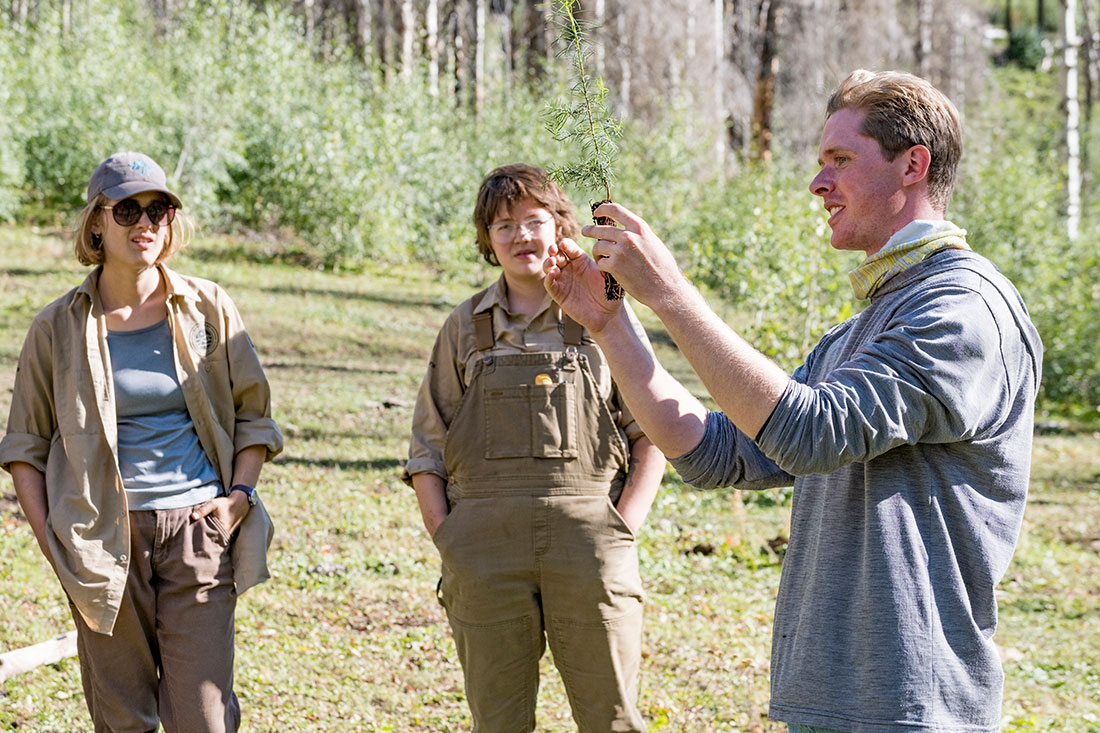
Photo Credit: Jason Houston / American Forests
“This will become second nature by the end of tomorrow,” Austin Rempel chimes in. As American Forests’ senior manager of forest restoration, Rempel has been working closely with the U.S. Forest Service on this project for months, including helping provide some of the funding. He’ll oversee much of the initial planting for the first four days, providing guidance to the SCC crew and planting as many trees as he can himself.
It’s time to hit the trail. They all head out of the parking lot to the trailhead covered by an archway of trees and quickly disappear around a curve.
A CATASTROPHIC FIRE? YES AND NO.
The 416 Fire started on June 1, 2018, 10 miles north of historic Durango, the largest municipality in southwest Colorado’s La Plata County. The name derived from the Dispatch Incident Number assigned to the fire. Allegedly sparked by burning embers from the Durango & Silverton Narrow Gauge Railroad, a National Historic Landmark that is a major tourist draw in the region, the wind-driven fire quickly spread to the nearby San Juan National Forest.
By the time the fire was fully contained on July 31, it had burned more than 54,000 acres, including Dutch Creek, a tributary of the Hermosa Creek that feeds into the Animas and San Juan Rivers. It was one of the largest wildfires in Colorado history and has had lasting impacts on the economy of Durango and Southwest Colorado due to evacuations of more than 1,000 homes; closure of businesses and tourist attractions such as Purgatory Ski Resort; and the cancellation of Silverton’s famed July 4th fireworks.
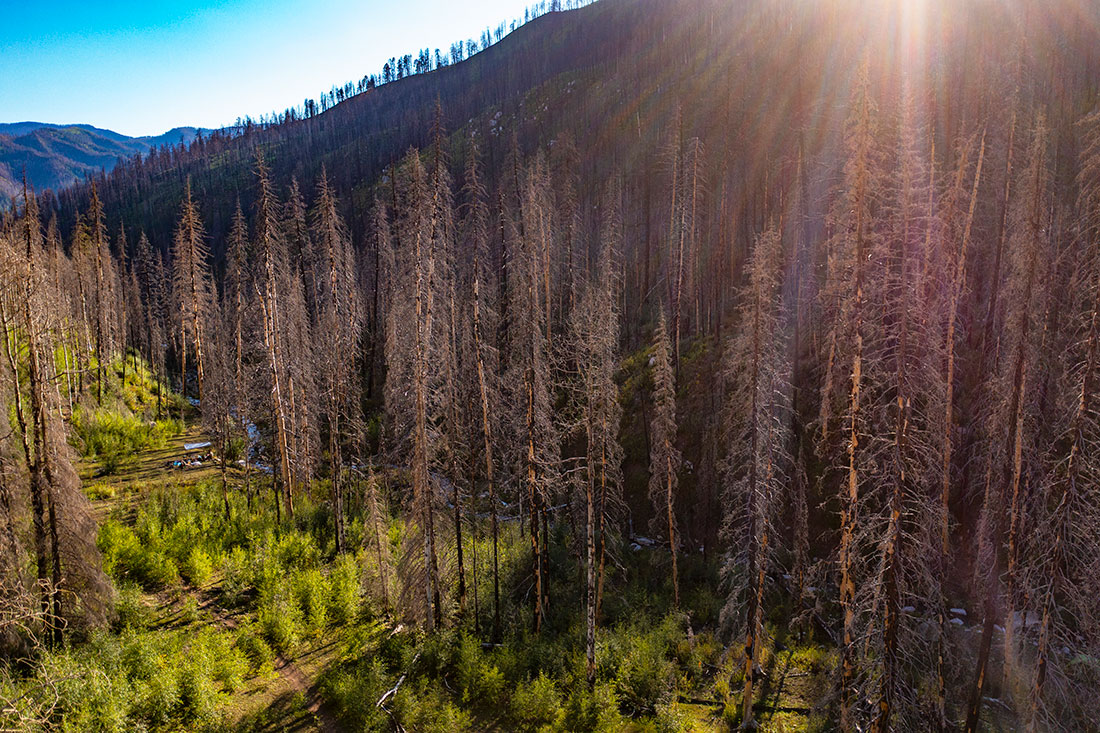
Photo Credit: Jason Houston / American Forests
Before the fire, Dutch Creek had a reputation as the most productive tree-growing area in the forest, home to several “Champion Trees” — the largest of their kind in the state. Most of the watershed’s trees were killed, eliminating the shade needed to keep water temperatures livable for trout and choking the stream with soil that washed in from charred mountainsides denuded of tree canopies and roots.
While it did produce serious damage in Dutch Creek and elsewhere, the 416 Fire was actually a mixed-severity fire that overall was quite healthy for the landscape, says James Simino, district ranger for Columbine. “We got a pretty good mosaic burn in an area that hasn’t seen fire in a long time. The critical piece for Dutch Creek is that it had a high-severity burn in there. It took out the seed sources to germinate naturally or regenerate vegetation naturally.”
Simino stresses the importance of Dutch Creek to downstream users since it feeds into Hermosa Creek, which is essential for agricultural irrigation. “Anything we can do to get good vegetative cover back in that area is really important. It prevents sediment from going downstream.”
Julie Korb, a fire and forest ecology professor from Fort Lewis College in Durango, has similar impressions of the fire, noting that only 3% burned at high severity like in Dutch Creek. With support from American Forests and Salesforce, Korb has been studying the 416’s post-fire regeneration, setting up 90 permanent research plots within the burn area at different levels of burn severity.
Three years after the fire, she is seeing very low conifer regeneration across the 416 Fire scar, and almost none in high-severity burn areas such as Dutch Creek. Non-conifer species, such as aspen and shrubs, however, are coming back strong in all locations due to underground root sprouting. That’s why it’s important to restore the conifers.
“Plantings like those in Dutch Creek are critical to maintaining watershed health long-term and also maintaining forest cover in areas that burned as high severity,” she notes.
CAMPING IN AN OVEN
It takes the crew about three hours to reach the campsite, long after the horses have offloaded their seedlings and begun heading back. The crew drop their packs in a gently sloping meadow wedged between dramatic mountainsides split down the middle by the burbling Dutch Creek. Charred and dead trees are everywhere, some of them already fallen.
There won’t be any planting today, but Rempel gives them a briefing for the next day before they make camp. “Look for inspiration” in terms of where to plant trees, he says, while noting that the Ponderosa pines need to go higher up on the slope while the Douglas-fir and blue spruce should be closer to the river. “It was a big fire, and you are standing in the very worst of it,” he adds. He points down the valley and describes how Dutch Creek is famous in the Forest Service because this is where their biggest trees are.
“Down that way was the biggest blue spruce in Colorado. And, unfortunately, it burned along with another Champion Tree,” he says wistfully.
“It’s called Dutch Creek, but the Forest Service calls it ‘Dutch Oven,’ because it got so hot.”
— Austin Rempel, Senior Manager of Forest Restoration, American Forests
UP AND AT ‘EM

Photo Credit: Jason Houston / American Forests
It’s around 6 a.m., with temperatures in the low 40s and several hours before sunlight hits the valley floor. The SCC Crew have already scarfed down their breakfast and coffee and are doing their morning calisthenics and safety check. Energetic and enthusiastic, they are amped up and ready to get going.
The crew members each choose a species to plant, load up their panniers and spread out across the valley. River Curry takes Ponderosa pine and spends the next eight hours moving across a steep slope with the agility of a mountain goat.
Rempel spends the morning darting up and down the valley. He alternates between giving planting tips to the crew, explaining the history and science behind what they’re doing, and trying to plant as many seedlings as possible. “These are grown from seeds that Gretchen collected from the trees in this area before they burned,” he says. “With these big fires, we’re losing entire genetic strains of trees, so we’re lucky to have this seed, and we’re lucky to have these seedlings.”
Crew members Emma Bernstein and Isabel Slaymaker, working as a team planting blue spruce, pause to ponder the deeper meaning behind their work. “I feel like I really care about them, they’re sweet, cute little baby trees,” Slaymaker says. “It feels exciting putting new life into the forest.”
“The fact that we plant the baby trees next to these huge trees that were once giants and have died, it’s kind of cool that they provide the shelter that the little babies need to grow,” Bernstein adds. “It’s like even though they’ve died, they’re still producing new trees and repopulating the forest.”
CHANGING THE FACE OF FORESTRY AND CONSERVATION
It’s no coincidence that this particular SCC group came together. They found each other on a job board dedicated to connecting LGBTQ+ individuals and proudly call themselves “The Queer Crew.” They say it’s important for them to have a place where they feel comfortable, are not judged and can show the world that the traditional straight, male-dominated world of forestry and conservation is evolving.
“I’ve worked and recreated in a lot of outdoor spaces, and it is very male-dominated,” says
Slaymaker. “And this crew, it’s been really amazing, because we’re all queer, and we come from different backgrounds, but we have certain shared identity and experience that we’re able to really talk about, in a serious way, as well as joke about. I’m empow- ered. And I have this confidence. I definitely think by letting go of some of that, we are serving the forest better, and doing better work.”
“I’ve had outdoorsy jobs, where I felt like I had to hide a part of me,” adds Nate Knaver. “And it’s really nice to feel completely comfortable and also represent a new queer crew in outdoor jobs. I’m noticing it more frequently.”
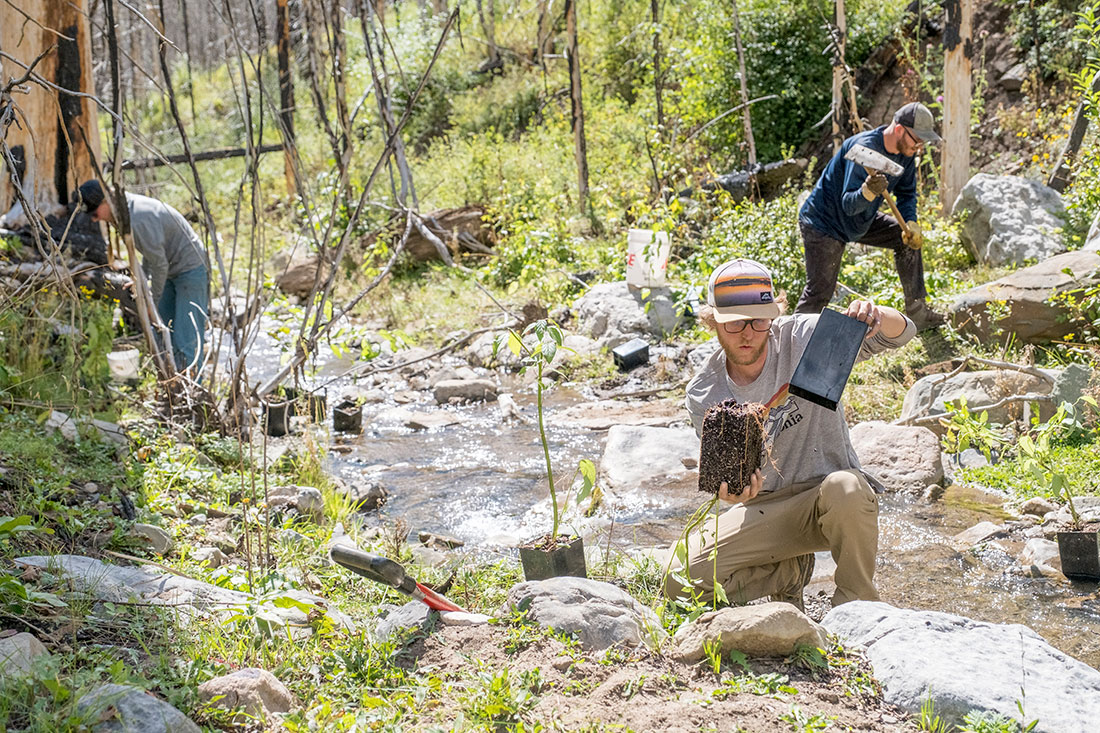
Photo Credit: Jason Houston / American Forests
A HOMECOMING OF SORTS
In her new job in the Sequoia National Forest, Fitzgerald oversees wildlife, vegetation, range management, hydrology and GIS work. While she no longer works on the San Juan National Forest, she wanted to return here to see the completion of a project conceived three years ago in the ashes of the 416 Fire. While working on the Burned Area
Emergency Response (BAER) Team, Fitzgerald recognized both the challenges and the opportunities in reforesting Dutch Creek.
“It’s a lot of effort for a small area, but to be able to go in, so far from the road and address a high impacted area — it was the area of biggest concern for sure,” Fitzgerald says. “I was developing it in my mind, but never really thought we would do it, because it’s a little impractical. So, I’m super excited that we’re doing it and that Joni took it on.”
The intense work began in December 2020, when funding from the Forest Service and American Forests was approved. Fitzgerald and American For- ests have a long history — the organization funded her first and last planting projects in the San Juan National Forest and is now supporting her newest work protecting sequoia trees in California.
Given that this project is ultimately focused on protecting Dutch Creek and several springs in the area, it was natural that a water expert like Vanderbilt would lead the project after Fitzgerald moved on.
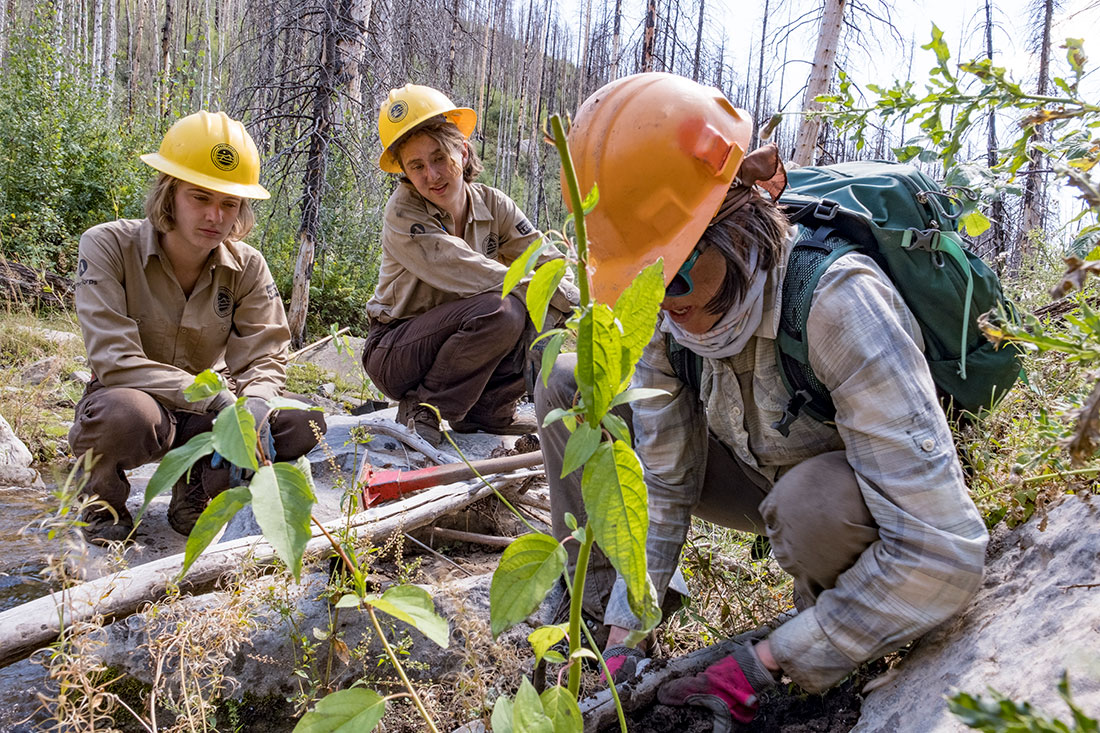
Photo Credit: Jason Houston / American Forests
The riparian shrubs that Vanderbilt and her team are planting will improve water quality downstream, especially in the Animas River, a “gold medal” fishery that is home to rainbow trout, Colorado cutthroat trout and San Juan cutthroat trout. The San Juan lineage was previously thought extinct until it was “re-discovered” using advanced DNA testing.
“The riparian plants do a lot to improve the water quality of our streams,” says Vanderbilt, who in her spare time plays mandolin in the San Juan String Band with two other colleagues. “[The water temperature] is going to be elevated for a while, but, hopefully, the riparian species will shade it, give it a little protection from the heat and then it will be a great input into the Hermosa for the fish and water users downstream.”
The one thing she is concerned about overall is how dry conditions could affect the seedlings. With a recent heatwave and no rain in sight, she’s worried about the seeds making it until winter, when they are protected from harsh conditions by entering dormancy. “It’s been a hot September, the soils are dry and it’s going to be warm, so [the seedlings] are not going to be dormant,” she says. “There’s always something to worry about!”
A WILD RIDE
With planting going at full speed, by day three it’s time for a new batch of seedlings to arrive. Because the new deliveries are needed further down the valley than the first batch, the horses need to take a short cut directly to the planting locations. So instead of gently descending into the valley to the campsite, they take a sharp turn down a steeper hillside.
With each rider leading a second packhorse with a rope, they descend through the charred forest with the panniers full of fresh seedlings bouncing from side to side. Just before they reach the valley floor, they hit a particularly steep section and dust begins flying in a frenetic few seconds of action that wouldn’t look out of place in a John Wayne movie.
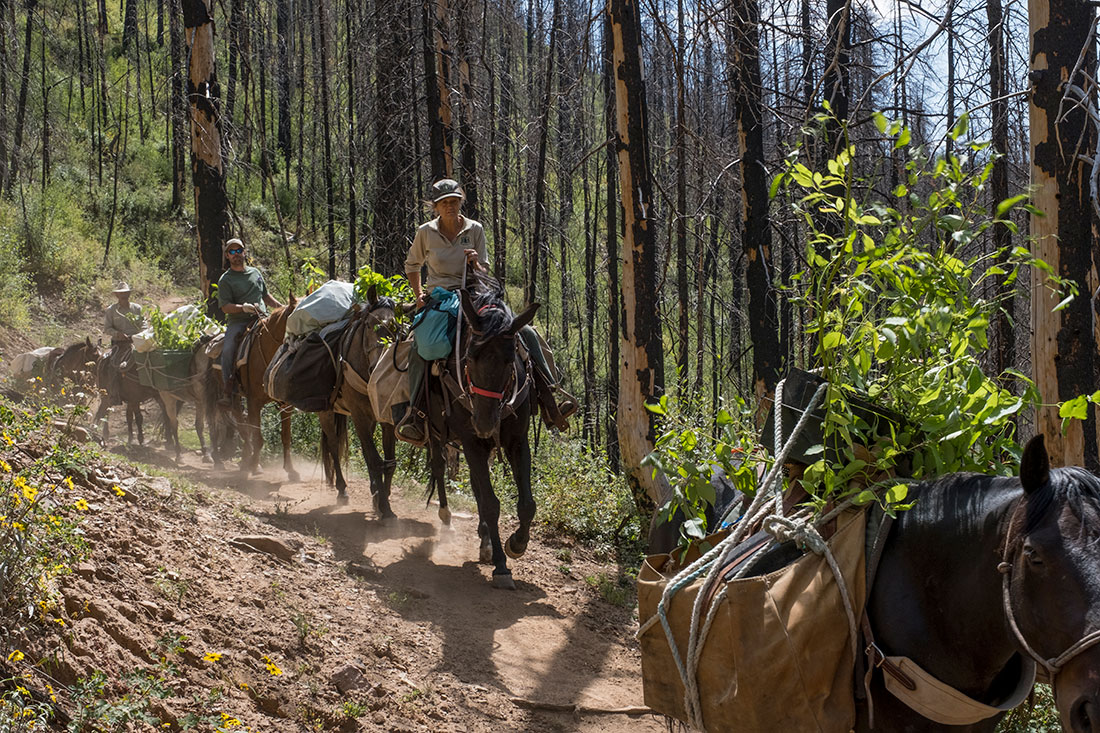
Photo Credit: Jason Houston / American Forests
Once down, the team members unload the new arrivals, then tie the horses up and let them feed on the bushes. However, one grey horse with the fitting name of Dutch seems particularly agitated, loudly neighing at the next horse over before delivering a brutal two-hoofed kick to its haunches. The first pack of horses were provided by an outfitter, but these are Forest Service horses usually reserved for more routine range management activities. Several of them are formerly wild mustangs, including two that have only just been “gentled” (trained to be responsive to commands).
Range Specialist Technician Sean Kelly, a former marine, hunting guide and ski lift operator, says he and his team have been preparing the horses all summer for this trip. He watched the 416 Fire burn for weeks from his former work location on the Carson National Forest. After moving to the San Juan National Forest in spring 2021, he began talking with Vanderbilt about Dutch Creek and offered to do the work.
“Packing trees was a new one for me, as you saw with them poking all over the place,” he laughs.
Before heading back to Hermosa with the horses, Fitzgerald takes time to check on the work of the SCC crew. Always the teacher, she corrects their hoedad technique, planting locations and spacing selection, not hesitating to tell them firmly but gently if they are doing it wrong. They pepper her with questions about Dutch Creek, the 416 Fire and her new job in Sequoia National Forest. “It’s really fun having everybody up here, and it’s kind of a crazy idea to come up here to plant trees,” she says. “But it’s really fun to see it happen.”
As Rempel collects GPS data of the new plantings, he expresses confidence that the three years of planning and hard work will eventually pay off.
“We’re providing a seed source for the future,” he says. “This will be the core island of trees that will eventually spread and have the genetics here. These trees will defend and protect Dutch Creek. They will grow fast if they survive. This is an extremely productive area, and I hope these trees will do well.”
Lee Poston is a communications advisor who works with mission-driven organizations and writes from University Park, Md.